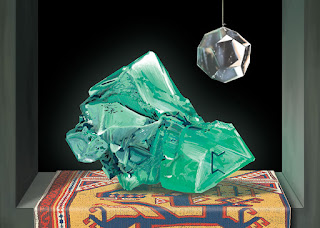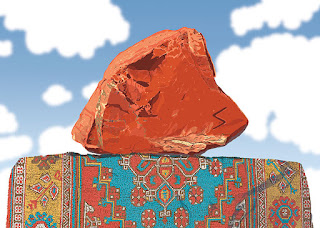Friday, 10 March 2023
Topaz video: how I created it!
Monday, 31 October 2022
Chrysolite Video: how I created it!
Monday, 19 September 2022
Carnelian
In "Carnelian", la cui traduzione è Corniola, viene rappresentato il minerale in primo piano con incisa la runa Thurisaz, la cui capacità è di difenderci e proteggerci, ci invita alla calma e alla riflessione. La Corniola è indicata come sesta pietra di fondazione delle mura della Città Santa nell’apocalisse di Giovanni e indica l’apostolo Tommaso. Accanto alla pietra vi sono rappresentati alcuni attributi dell’apostolo, la squadra, il libro e la lancia. La pietra poggia sopra un tappeto Palas, del Tajikestan del XIX secolo. Il tappeto è un omaggio al divino e per sua natura crea un’atmosfera mistica, ad ogni nodo intrecciato è legato il pensiero di chi lo ha lavorato dedicandovi ore della propria vita. Su di un tappeto persiano è stato scritto: “Hanno filato la sua trama col filo dell’anima”. Questo lavoro appartiene alla serie intitolata "Way back into Soul", in cui sono rappresentati antichi miti in chiave moderna.
In “Carnelian", the mineral is represented in the foreground engraved with the Thurisaz rune, it has the ability to defend and protect us, it invites us to calm and reflect. Carnelian is indicated as the sixth foundation stone of the walls of the Holy City in the apocalypse of John and indicates the apostle Thomas. Next to the stone there are represented some attributes of the apostle, the square, the book and the spear. The stone rests on a Palas carpet from 19th century Tajikistan. The carpet is a tribute to the divine and by its nature creates a mystical atmosphere, the thoughts of those who worked on it are linked to each intertwined knot, dedicating hours of their lives to it. On a Persian carpet it was written: "They spun its weft with the thread of the soul". This work belongs to a series entitled "Way back into Soul", in which ancient myths are represented in a modern way.
Monday, 30 May 2022
Emerald
In "Emerald", la cui traduzione è Smeraldo, viene rappresentato il minerale in primo piano con incisa la runa Perth la cui capacità è di rigenerazione e di donare entusiasmo. Lo smeraldo è indicato come quarta pietra di fondazione delle mura della Città Santa nell’apocalisse di Giovanni e indica l’apostolo Filippo. Lo smeraldo poggia sopra un tappeto anatolico del xv secolo, con il disegno del Drago e della Fenice, mentre sullo sfondo è appeso un dodecaedro di cristallo, che simboleggia il cielo stellato. Il tappeto è un omaggio al divino e per sua natura crea un’atmosfera mistica, ad ogni nodo intrecciato è legato il pensiero di chi lo ha lavorato dedicandovi ore della propria vita. Su di un tappeto persiano è stato scritto: “Hanno filato la sua trama col filo dell’anima”. Questo lavoro appartiene alla serie intitolata "Way back into Soul", in cui sono rappresentati antichi miti in chiave moderna.
In “Emerald", the mineral is represented in the foreground engraved with the Perth rune, it has the ability is for regeneration and to give enthusiasm. Emerald is indicated as the fourth foundation stone of the walls of the Holy City in the apocalypse of John and indicates the apostle Philip. The emerald rests on a 15th-century Anatolian carpet with the design of the Dragon and the Phoenix, while in the background hangs a crystal dodecahedron, symbolizing the starry sky. The carpet is a tribute to the divine and by its nature creates a mystical atmosphere, the thoughts of those who worked on it are linked to each intertwined knot, dedicating hours of their lives to it. On a Persian carpet it was written: "They spun its weft with the thread of the soul". This work belongs to a series entitled "Way back into Soul", in which ancient myths are represented in a modern way.
Wednesday, 9 March 2022
Sapphire
In "Sapphire", of the blue variety, the mineral is represented in the foreground engraved with the Thurisaz rune, it has the ability to defend and protect us, it invites us to calm and reflect. Sapphire is indicated as the second foundation stone of the walls of the Holy City in the apocalypse of John. The sapphire rests on the Holbein carpet, so called because it was widely used by the painter in his works during the Renaissance. The carpet is a tribute to the divine and by its nature creates a mystical atmosphere, the thoughts of those who worked on it are linked to each intertwined knot, dedicating hours of their lives to it. On a Persian carpet it was written: "They spun its weft with the thread of the soul". The composition rests on a low wall and an intense spiritual energy is released around the stone. This work belongs to a series entitled "Way back into Soul", in which ancient myths are represented in a modern way.
In "Sapphire", la cui traduzione è Zaffiro, della varietà blu, viene rappresentato il minerale in primo piano con incisa la runa Thurisaz la cui capacità è di difenderci e proteggerci, ci invita alla calma e alla riflessione. Lo zaffiro è indicato come seconda pietra di fondazione delle mura della Città Santa nell’apocalisse di Giovanni. Lo zaffiro poggia sopra il tappeto Holbein, chiamato così perché largamente usato dal pittore nelle sue opere durante il Rinascimento. Il tappeto è un omaggio al divino e per sua natura crea un’atmosfera mistica, ad ogni nodo intrecciato è legato il pensiero di chi lo ha lavorato dedicandovi ore della propria vita. Su di un tappeto persiano è stato scritto: “Hanno filato la sua trama col filo dell’anima”. La composizione poggia su di un muretto e intorno alla pietra si sprigiona una intensa energia spirituale. Questo lavoro appartiene alla serie intitolata "Way back into Soul", in cui sono rappresentati antichi miti in chiave moderna.
Wednesday, 23 February 2022
Jasper




